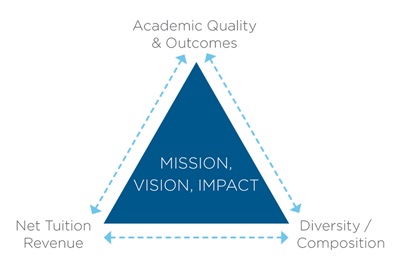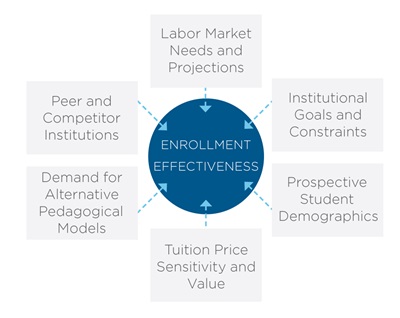In Brief
It is more important than ever for colleges and universities to vary their tactics for reaching different groups of students while developing an overall identity and messaging that is in concert with the strategic plan of the institution and its unique mission.
Recent years in the higher education landscape have been marked by significant volatility and uncertainty from what had been a reasonably stable enrollment environment. As a result, enrollment managers face increasing challenges in recruiting and enrolling the most appropriate students to shape a class that meets the institution’s needs and goals. Equally troubling, the dynamic and rapidly changing elements of the competitive enrollment landscape are difficult to monitor and analyze for many institutions, especially given the wide variety of competing priorities facing university and college leadership.
In today’s environment, a successful enrollment strategy must involve leaders at all levels of the institution, be tied to an institution’s mission and be clearly understood by the campus community. The enrollment process should join the admissions, financial aid and student-support functions together with analytic tools, academic and financial planning, and a multidisciplinary focus consistent with institutional mission and strategic objectives.
Despite various attempts by enrollment managers to help leadership understand that managing enrollment is much more than just recruiting and admitting students, at many institutions, “enrollment” is synonymous with “admissions.” The historical emphasis on “input” factors, such as application and yield rates, that are so important to college rankings has led some institutions to focus on these narrower metrics rather than the successful and seamless student lifecycle that extends the full range, from recruiting to alumni engagement. With a new and welcome shift in evaluation criteria to a mix of “input” factors and “output” factors, including retention and graduation rates, institutions must adapt to a more comprehensive and inclusive approach to understanding enrollment. Enrollment needs to focus not only on admitting students, but also on ensuring successful student progression and completion.
This longer-term view of enrollment requires institutions to focus beyond just first-year net tuition revenue (NTR), balancing initial with lifetime NTR. Each institution must invest the resources required to ensure student development and success, taking a holistic view around enrolling and aiding students that the institution can support through graduation.
Huron 2019 Graduate Survey Report
Read Huron's recent graduate survey report for insight into what the evolving student preferences mean for the campus experience.
Read More
Multiple (and Ever-Changing) Enrollment Tradeoffs
There is inherent tension in balancing competing priorities in enrollment: academic quality, NTR and diversity (that is, the composition of the entering class, including ethnicity, gender, domestic and international geography, athletics, legacy and alignment with available degrees/programs). Until recently, the admissions office at many institutions was fully responsible for managing an incoming class. However, with changing demographics and intensifying competition in higher education, leaders across the entire institution must collaborate to set and guide the institution’s enrollment strategy in order to fulfill its strategic objectives and mission and to ensure that it has sufficient revenues to do so. Each institution will have to balance what is important and achievable among competing priorities.
Pressures on institutions’ enrollment effectiveness will continue to intensify over the next decade as tuition price sensitivity increases and demographics continue to change across the country — with expectations of growth in some areas and reductions of traditional student populations in many highly competitive higher education markets. Understanding an institution’s position in its competitive landscape and the specific challenges it will face can help leaders develop a multi-year enrollment plan that takes advantage of its distinctiveness within the market, develops a communication style and relationship-building approach that draws appropriate prospective students, and considers a variety of student types (i.e., undergraduates, transfer students, international, part-time, full-time, post-traditional and graduate students) to ensure overall enrollment success.
While enrollment goals of all institutions may be similar — such as ensuring stable enrollments and net tuition revenue — the strategies for navigating each institution’s enrollment pressures are different based on the institution’s unique profile, its competitor mix, the types of students it serves, its academic offerings and enrollment catchment areas, and the social and economic environment in which it operates.
To ensure enrollment alignment and stability, Huron recommends a holistic approach that includes comprehensive market research and a thorough and objective evaluation of its own capabilities. In the current environment, no institution can meet its enrollment challenges simply by utilizing a single enrollment tactic or focusing on one narrow student population. Each institution must create its own effective mix of enrollment strategies and tactics that recognize its financial and operational realities, its position in its competitive market and its ability to deliver educational programs and outcomes that address the needs of students, faculty and a variety of other stakeholders.
The first step in answering this complex enrollment question lies in understanding how the institution views its enrollment market. Understanding the institution’s mission, challenges and opportunities and explaining them in such a way that every stakeholder understands and internalizes them is the best way to create support for a multi-year, comprehensive enrollment strategy that can be embraced by the entire campus community.
Weighing Enrollment Factors
Nearly every institution in higher education is struggling to respond to a myriad of factors in enrollment:
- Price Sensitivity and Value: Price competition has intensified as the availability of college-pricing information has grown, the lingering effects of the recession remain and the national conversation regarding rising college costs continues. Students and families are increasingly eliminating some colleges and programs from consideration based on perceptions that they are too expensive and that the total cost may not be justified by graduates’ future employment prospects.
- Increasing Ethnic Diversity: The number of white high school graduates is projected to continue its decline, and colleges that have not historically served minority students must position themselves to embrace, engage and support a more ethnically diverse student pipeline through graduation. With underrepresented minorities’ lower propensity to attend college, institutions will need to proactively recruit and attract a diverse student body to their campuses or face declining enrollments.
- Geographic Shifts: The number of U.S. high school graduates is expected to decrease by 2.1 percent during the next 10 years. While changes in the number of graduates vary by region, the most significant declines will be in the Northeast and Midwest, where the majority of colleges and universities are located.
- College Preparedness: Many students are not meeting minimum educational benchmarks that indicate college readiness and more students will require remedial support in the coming years, taxing university resources.
- Changing Academic Interests and Emphasis on Professional Outcomes: Many institutions have focused internally on building resources for their academic programs but have spent less time focused on skills needed by labor markets and the career interests of current and prospective students. In addition, an increasing demand for flexible schedules and the use of new academic technologies and pedagogical models requires new resources and operational approaches.
Many colleges must respond to other factors as well. For example, colleges and universities with religious affiliations must consider the decline in secular identity among the U.S. population; rural colleges must consider the increasing reluctance among students to attend college outside of urban areas; and colleges with a limited number of academic programs must compete with a perception among some students that they will limit opportunities and not be able to offer the interdisciplinary programs that are gaining in popularity.
Understanding Your Institution's Competitive Position
To have a realistic view of an institution’s standing in the competition for students, it is essential that institutional leaders develop a comprehensive and accurate understanding of the institution’s position both internally and externally. While leaders should consider many of the common enrollment metrics (i.e., applications, acceptance rate, yield, etc.), leaders should also consider other factors that affect competitive position and attractiveness to students, including:
- “Sticker” price versus net price
- Average tuition discount
- Cross applications — which institutions regularly “win” in competition for the same applicants and which others does the institution regularly “defeat”
- Available academic capacity across programs and understanding the cost to educate by program
- Retention and graduation rates
- Employment outcomes and career placement statistics
Constituent research can help institutions understand how they are perceived by potential students and identify programs that students believe are most relevant and in-demand, as well as those that are not perceived to be useful to future careers. This research can highlight competitive advantages and identify themes useful for creating marketing and communications materials that help differentiate the institution in a crowded education marketplace and expand student interest. In addition, this type of analysis can be used to answer an array of tuition-pricing questions, from evaluating price sensitivity to understanding relative pricing power (especially for stronger programs) to assessing potential students’ perceptions of the value of the program relative to cost and future earnings potential. Pricing data can help institutional leadership determine whether discounting mechanisms based on student demand may be effective tools and identify appropriate pricing approaches to attract, recruit and retain students of all types.
Recruiting Patterns and Market Demand
Each institution needs to have a clear and precise understanding of its realistic opportunities for growing its applications and expanding enrollment. Important data for institutional leadership includes:
- Characteristics of students who apply to the institution and of those who succeed
- Awareness of whether primary recruiting markets are growing or shrinking
- Identification of other recruiting locales where prospects’ interest is growing but institutional relationships are negligible
- Understanding which programs are in highest demand among prospective students
- Awareness of how well available academic capacity aligns with student interests that might have the ability to grow
- Extent to which academic programs that are popular could be expanded or created to meet student demand
Closely related to prospective students’ increasing price sensitivity, students and their families are more interested in whether specific programs will lead to valued careers. Students are increasingly less likely to choose a field of study if they think they won’t be able to find an appropriate job after graduation. Colleges and universities must not only consider the popularity of their programs, but also whether those programs will produce graduates that industry will need 10–15 years in the future. Investing in market research to understand labor market trends helps leadership ensure that academic programs align with institutional mission, broader strategic objectives and economic development while helping to develop appropriate career-support services for students.
The Optimal Student Mix
Defining the kind of students the institution wants to attract and the tradeoffs it is willing to make is a critical step for institutional leadership. Establishing a common enrollment philosophy will help align efforts and ensure enrollment success. Most importantly, the institution must look for students who have a high propensity to enroll, who are aligned with the mission of the institution and who, consequently, are more likely to retain and graduate. For example, if the institution is mid-size, suburban and has a strong religious heritage with a large commitment to public service, it makes more sense to admit students who are drawn to all of those attributes, even if the students’ test scores may fall below the desired target. Not only is it much more difficult to successfully recruit and yield a student not fully aligned with institutional mission, but it is also more difficult to retain those students throughout their academic careers.
Ultimately, it is less expensive to recruit a student whose personal goals are consistent with institutional culture and identity, and who will enroll and remain than to constantly recruit new students to replace those who leave early.
While admissions offices have historically been built to focus on bringing in a class of freshmen undergraduates, a more successful approach to meeting enrollment goals is to think about the many types of students who may have interest in the institution, whether they are part-time, full-time, transfers, adult students, undergraduate or graduate. The core principles remain, irrespective of student type: If a potential student is a good match with the institution’s mission, goals and culture, the student should be pursued, regardless of when or how they might enter. To promote this philosophy, leadership should incent and reward admissions efforts that bring in the right — not just the right-sized — class with the right mix of students of all types.
Attracting each of these types of students is not easy for a college or university that has focused primarily on its entering full-time, first-time freshman class. New technology, programs and operations — in areas such as registration, housing, advising and campus life — should be carefully planned to make all varieties of students feel welcome. Leadership must also consider how best to coordinate enrollment and other student activities across the institution to ensure that students are supported throughout their academic career.
A New Lens for The Future
Higher education is collaborative by nature. While higher education has always been somewhat competitive, the recent and more intense level of competition for students demands that each institution act with an understanding of the forces that impact student choice, including its position relative to competitors and the perceived value of its academic programs. The new environment requires institutions to develop distinct market identities that enable the creation of multiple communication approaches. It is more important than ever for colleges and universities to vary their tactics for reaching different groups of students while developing an overall identity and messaging that is in concert with the strategic plan of the institution and its unique mission.
For successful student enrollment, a college or university must change the lens through which it sees itself. To the greatest extent possible, institutional programs and activities must be evaluated from the student perspective, with student needs being the foundation that have more influence on institutional and administrative structures. The market for students is getting more and more competitive. The institutions that will be most successful in the future will be those that recommit to being student-centered, focused on student success.
KEY TAKEAWAYS
-
Think differently.
Focus not only on admitting students, but also on ensuring successful student progression and completion. -
Plan differently.
Align priorities from every department on campus and think deeply about your institution’s priorities and mission. -
Act differently.
Evaluate institutional programs and activities from the student perspective, with student needs being the foundation.


